The ASUS ROG Crosshair VIII Impact: A Sharp $430 Impulse on X570
by Gavin Bonshor on October 25, 2019 11:30 AM ESTBIOS
The ASUS ROG firmware is very consistent throughout its range which is good for brand awareness with its red and dark grey theme, with white test and deep red highlighting when hovering over each setting. There are two different modes to select from; an EZ (easy) mode for users looking to make basic changes, and an advanced mode which opens up a wealth of settings and options for overclocking.
The EZ mode is very easy to navigate with plenty of basic functions which include allowing users to apply X.M.P memory profiles, something ASUS calls D.O.C.P. Users can also alter the boot priority and access the Q-Fan control settings, as well as see basic information about the processor, the firmware version, and fan speed information. The information on the memory is very basic with the brand, capacity, and basic SPD profile speed of the installed memory.
Pressing F7 key within the firmware allows users to switch between the Ez and advanced modes. Entering the advanced mode opens up on the main menu. The main panel displays a basic overview of information relating to the firmware version installed, the processor that's installed, and allows users to change the firmware language, the system date, time, and make security setting changes. It also opens up the extreme tweaker, advanced, monitor, boot, tool, and exit menus.
Moving to the extreme tweaker section, this is where all of the CPU and memory overclocking tools and settings are housed. Despite there being no actual overclocking presets to select from, users can use the Ai Overclock tuner to enable X.M.P memory profiles, or enter manual mode to customize both memory, and CPU frequency settings. Further down the extreme tweaker section is plenty of voltage control options for the CPU, memory, and things like SoC voltage, SB and PLL voltages. The performance enhancer setting allows users to select between three different levels of Precision Boost Overdrive which we have tested within the overclocking section of this review.
Below is a list of limitations when using the current firmware for settings such as CPU VCore, CPU frequency, DRAM frequency, and the Infinity Fabric/FCLK frequency. It should be noted that most of these maximum values won't even be able to be reached, even with extreme cooling methods:
- Maximum CPU Frequency = 6.375 GHz
- Maximum CPU VCore = 1.7 V
- Maximum DRAM Frequency = DDR4-6000
- Maximum Infinity Fabric/FCLK Frequency = 3000 MHz
Note - We didn't enable LN2 mode at any point during our testing as we didn't want to risk potential damage to our testbed hardware.
The ASUS ROG Crosshair VIII Impact also has a wide variety of memory settings as expected, with customizable settings for primary, secondary, tertiary, and voltage settings. ASUS has even included a few high-performance memory presets for overclockers looking to run quick memory profiles as a base to work from.
Within the hardware monitor which is quite comprehensive in terms of displaying temperatures, fan speeds, and the values from the water-cooling thermal probes on the board, the Q-Fan configurator allows users to create their own fan profiles. Users can set values based on fan limit fan speeds, as well as fan ramp up/downtimes. Not only are the 4-pin fans customizable, but the firmware allows users to control the two small 30mm fans integrated into the rear panel cover.
The tool menu opens up a variety of utilities including the ASUS EZ Flash 3 utility for upgrading the board's firmware. Other tools such as the ASUS SPD information allow users to check the official SPD profiles from memory, the graphics card information lists basic information about the installed GPU, and users can enable or disable the integrated ASUS Armoury Crate which includes the board's drivers and software.
Overall the ASUS ROG firmware is functional, responsive, and user-friendly with plenty of overclocking, power, and X570 chipset related settings for users to sink their teeth into. The most important aspect of firmware is in its stability and the ASUS ROG firmware is just that, strong and stable, with a plethora of features and functions.
Software
The Armoury Crate is a small pool of integrated storage where users can install drivers and software within Windows; this is promoted during a fresh Windows 10 installation due to a setting in the BIOS (this can be disabled). Users have the option to utilize the Armoury Crate or download and install the latest updates directly from the official product page, but the ASUS armoury crate does save time. The most notable software included with ROG Crosshair VIII Impact software bundle is the AI Suite 3 overclocking and power utility, the ROG Aura RGB LED utility and the ROG Gamefirst V networking utility.
The ASUS AI Suite 3 software offers a host of different functions including access to the Dual Intelligent Processors 5 utility which allows users to optimize system performance. This amalgamates the TPU, Fan Xpert 4, and DIGI+ VRM menus into one easy place where users can one-click optimize all the settings based on the hardware installed, and basic parameters such as temperature and clock speed. Users can also apply three different power saving profiles which are performance, power saving, and away mode.
ASUS has a very 'in your face' way of saying that it has automatic optimization functions and in the Fan Xpert section of the AI Suite 3 software, the right-hand side of the screen makes this clear. There are options to select between the smart mode and RPM fix mode, as well as the ability to customize the fan curves and fan spin times. Users can also enable the Critical Temperature checkbox which is set to 75°C by default; this is quite low given how hot Ryzen 3000 processors run when even mildly overclocked all-cores.
Simple, yet effective, the ASUS ROG Aura RGB software allows users to customize the RGB LED strip on the underside of the PCB at the right-hand side. Users can select between twelve different LED lighting profiles ranging from Color Cycle to Starry-Night, and sync settings between the integrated RGB LEDs and the two ARGB LED headers.
The ASUS Gamefirst V software is essentially its version of a networking traffic shaping utility which allows users to assign different applications priority based on how important it is. This is designed to provide a faster and more immersive experience when online gaming, which also logs bandwidth used and allows users to make quick-fire adjustments.
Overall the software package supplied is useful to users looking to make changes to settings within Windows, but with the exception of the ROG Aura and GameFirst V applications, all of these power and optimizations can be done within the firmware. As we have experienced on ALL of the X570 models tested so far, users looking for an immersive and enhanced audio experience will need to search and download Sonic Studio III from the internet, as the software itself isn't downloadable directly from the official product page.


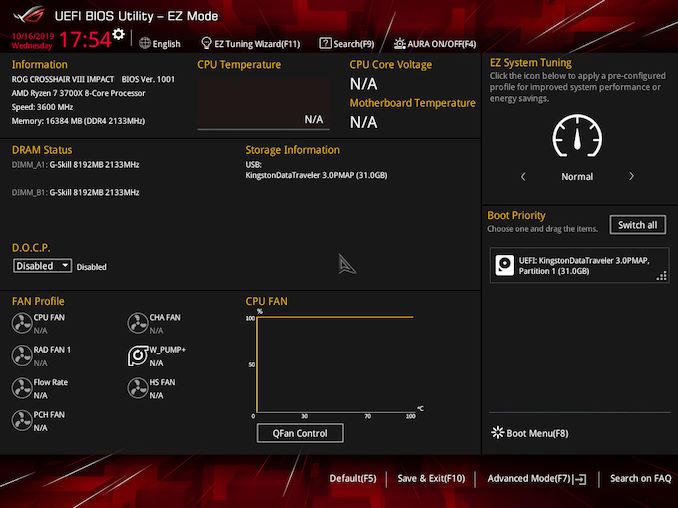
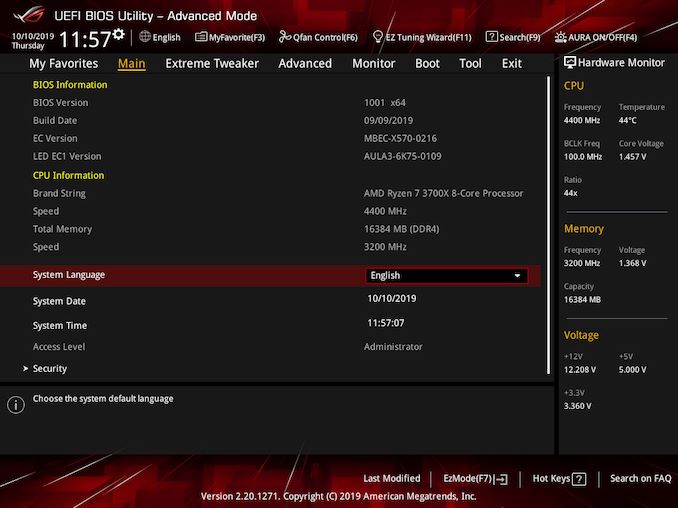
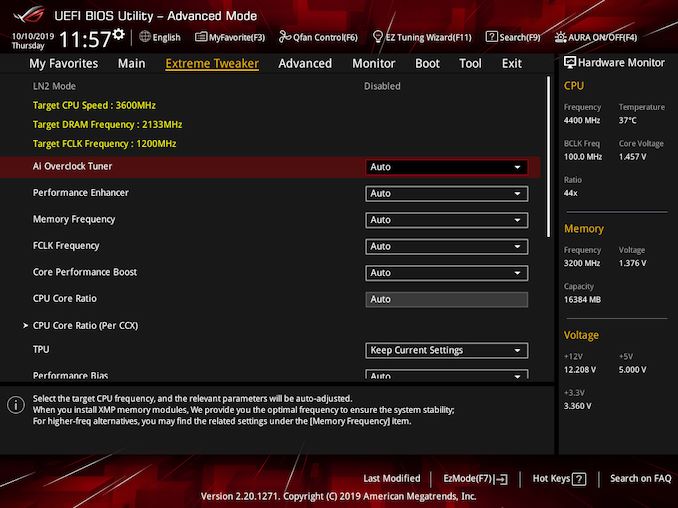
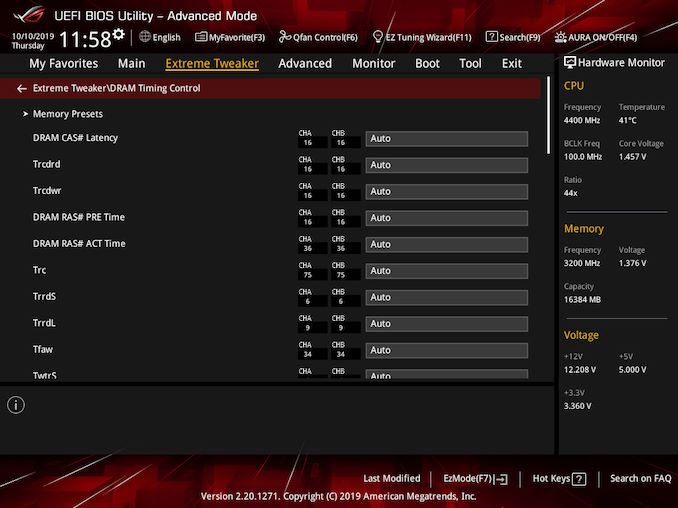
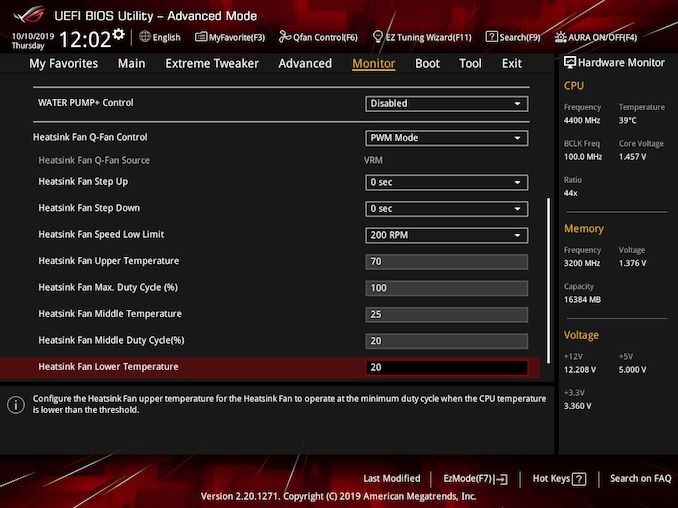
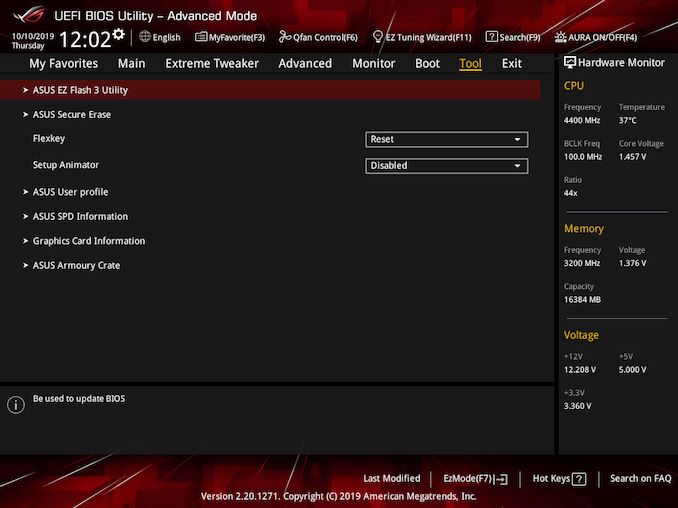






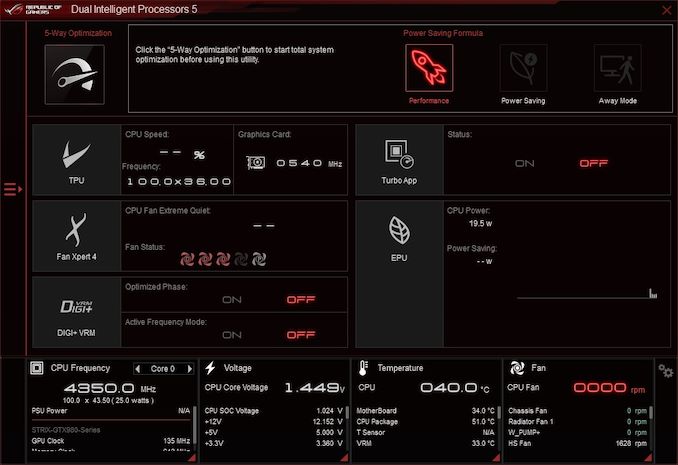
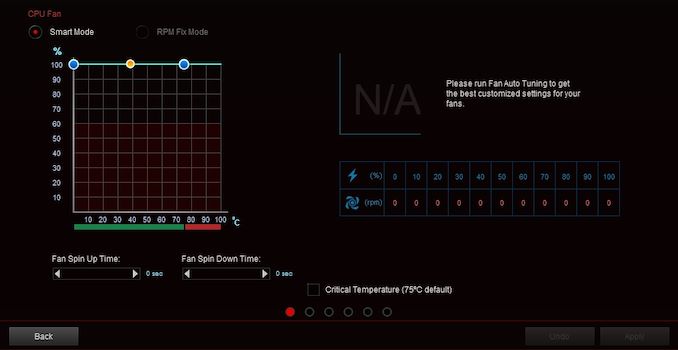
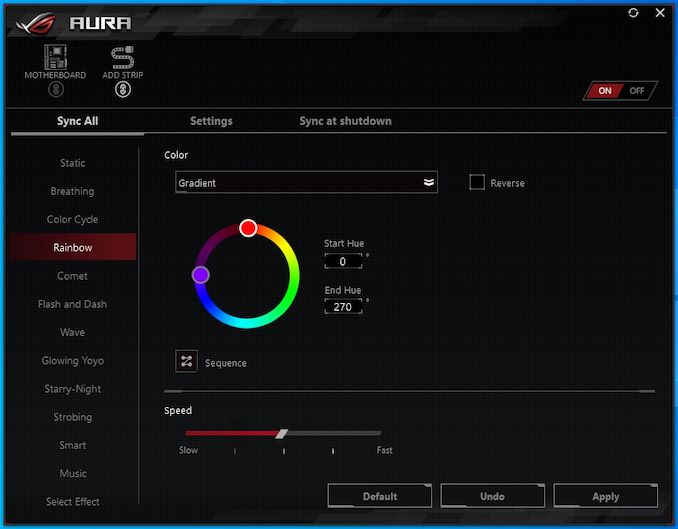
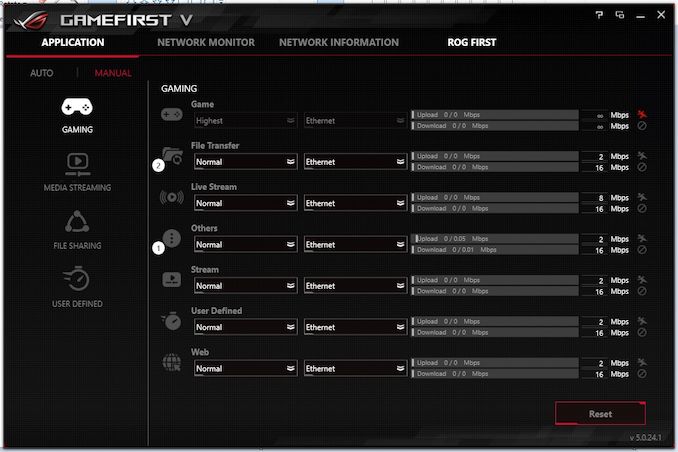














59 Comments
View All Comments
evernessince - Saturday, October 26, 2019 - link
It's the same people complaining on every article about the same issue, despite the fact that they've been told time and time again that these fans run at low RPM or off completely when you are not pushing the IO heavily. For most people, they are inaudible 100% of the time. These people want to spin their narrative, not try to understand what people are telling themHardwareDufus - Friday, October 25, 2019 - link
I won't say that I'm disappointed. I like Zen2.... but I will do just one more cycle of waiting.... I want to see the Zen3 successor to the Ryzen 9-3950X... and the RDNA 2 successor to the Radeon RX 5700 XT. That's all probably 12-15 months away, but that's just about right. I too am on an I7-3770k (longest lasting CPU I have ever had as well). This will be the last machine I build of my professional working career (If I've gotten 7+ years out of my I7-3770k, I'm sure I'll get 5 years out of the Zen3 16core CPU).hmmm, my trusty SilverStone SG055BB is mini-ITX / mini-DTX compatible (I own two of them). However, I'd pay a max of $300usd for a board like this (even though admittedly it's just about the perfect board... optical audio out, wifi and 2 M2 slots for storage... I ALWAYS have two harddrives).
We will see if a successor to this board is available in 12-15 months when I make the Ryzen Zen3 & Radeon RDNA-2 jump.
I'll be fine if only PCI4 is supported at that point.... I won't hold off for PCI5 to be implemented.
Will be interesting to see if we start seeing 4TB M.2 storage devices at that point as well... and if 32GB Dimms at good speed will be more affordable. Yeah.. Looking at 16 Cores @ 4Ghz+, 2X32GB for 64GB of Ram, 2X4TB for 8TB of storage to drive 2 32" 4K monitors. Will be a nice rig for the sunset years of my IT career...
alufan - Saturday, October 26, 2019 - link
honestly I do not understand folks who say this you have a CPU that is in modern terms slow and a system thats the same AMD comes along with a really disruptive product that is leagues ahead of what you have and in its third generation yet still you want to wait !What the heck exactly do they need to do to get your buy in, if AMD didnt exist or bring Zen to the party intel would happily keep chugging out its same CPUs for the next 10 years, support the company thats brought the fight to them!
HardwareDufus - Sunday, October 27, 2019 - link
Well, I will build the new system with cash on hand... So I may have misrepresented why I will sit out...... It's just that in my budget at end of 2020/2021 will make room for my computer. By then it will be Ryzen Zen 3 Radeon RDNA-2 and I will be curious to see what they offer... That's all. If their release is stalled significantly... then I 12 months from now I will buy current gen Ryzen Zen 2 Radeon RDNA....and would be equally delighted to do so...HardwareDufus - Sunday, October 27, 2019 - link
But perhaps in that time.... we will see a X570 variant that won't require a fan.... again, won't be a show stopper, as the CPU and Video cards will have fans aplenty anyway.....evernessince - Saturday, October 26, 2019 - link
And yet all X570 motherboards either turn off the fan during low load or run at low RPM, making then inaudible.PeachNCream - Sunday, October 27, 2019 - link
Noise isn't the concern. Fan failure is what bothers the OP as indicated by noting fans are a regression in the movement toward fewer moving parts (which can suffer from mechanical failure). While noise might be a concern, broken little fans that are a PIA to replace are what have peoples' panties in a twist right now and we haven't seen any X570 motherboards operating long enough to get a good understanding of whether or not fan failures are going to be a problem or if, as you implied, they are generally not running to begin with (which begs the question why the motherboard manufacturers are adding them in the first place instead of using a more effective passive heatsink).Oliseo - Sunday, October 27, 2019 - link
But you're not interested in anything but laptops, I don't get why you're arguing with people about something you no longer care about.Just like arguing I suppose.
RavenRampkin - Sunday, October 27, 2019 - link
May I kindly take Peach's initiative? xDNot interested in laptops. Have one, it's fine. The current pricing situation is meh. 6/12 ultrabook and 8/16 laptop parts are crazy expensive. Graphics are expensive (Turing), boring (Turing GTX) or both (Radeon, sadly. Power hogs or underperformers, or both). Zen is a skillful fighter for new users but nothing of particular interest over a good ol' 4700MQ (minus the Vega... got a dGPU anyway)...
As for the fans, sorry bud. If the interested customer has to find ways in which a hackjob (just sry, this IS a hackjob... it's not 2005 anymore) doesn't svck (oh the fans are low RPM, oh they're not that short-lived, oh there's passive mode at 0.1% load) and is actually *not that bad*, then it's not really a good hackjob. The need for this dayum fan in the first place screams a littley oopsie from ASMedia, or a design less efficient than usual on AMD's side. OK higher demands than for 300 and 400 series, then why does Shintel get away without le fans? (Pls correct if wrong.) Also, you can still do it passive, funnily enough. Why should it be a blessing and not a default option?
Case in point right above (or below?) me. Adaptation 100. Spare me some lube guys, been shilling for AyyMD, AsRock, Powercolor and Seasonic long enough :P want to try out some other companies
TL;DR there's no advantage nor purpose in reinventing the sleeve bearing (or dual ball, depends) wheel.
AshlayW - Monday, October 28, 2019 - link
PCI express 4.0 has significantly higher power requirements and thus heat output. X570 chipset is a repurposed Matisse IOD. Why you people complain about the chipset fan is beyond me, always gotta complain about something I guess. It's completely bloody inaudible on my X570M pro 4, and also completely unnecessary for all but the most intense I/o on both gen4 m.2 and the GPU.Stop complaining.